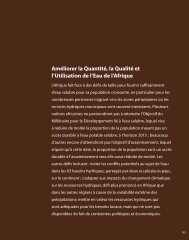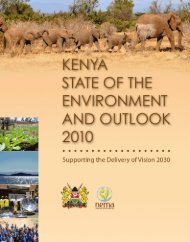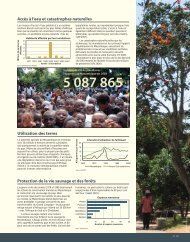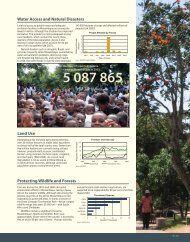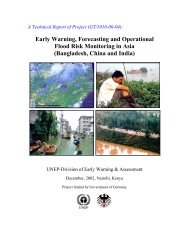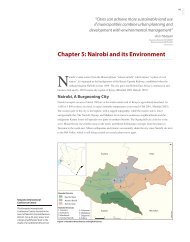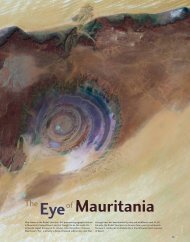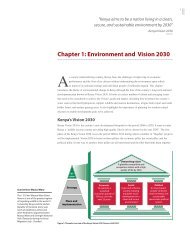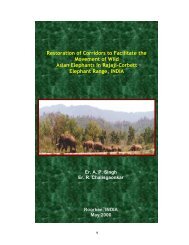Uganda Atlas of Our Changing Environment - GRID-Arendal
Uganda Atlas of Our Changing Environment - GRID-Arendal
Uganda Atlas of Our Changing Environment - GRID-Arendal
Create successful ePaper yourself
Turn your PDF publications into a flip-book with our unique Google optimized e-Paper software.
Wetlands: importance and uses<br />
28<br />
<strong>Uganda</strong>’s wetlands can be categorized as papyrus<br />
swamp, swamp forests, lacustrine (lake edge),<br />
riverine, flood plains and damboos. These can<br />
be further categorized into permanent and<br />
seasonal wetlands. The most common type <strong>of</strong><br />
wetland is papyrus swamp dominated by Cyperus<br />
papyrus. A bout 69% <strong>of</strong> the total area under<br />
wetlands is impeded drainage while seasonal<br />
swamps and swamp forests constitute 30% and 1 %<br />
respectively.<br />
Wetlands in <strong>Uganda</strong> perform important chemical,<br />
hydrological, ecological and socio-economic<br />
functions. The major functions and values include;<br />
source <strong>of</strong> products such as water, fish, forage and<br />
grazing resources, wood fuel, building and craft<br />
materials, sand, clay and medicines; provision<br />
<strong>of</strong> services such as purification <strong>of</strong> water through<br />
filtering <strong>of</strong> both silt, and industrial and domestic<br />
effluent; regulate water flow and enhance ground<br />
water recharge; moderation <strong>of</strong> climate; retention<br />
<strong>of</strong> carbon; and provide landscape aesthetic<br />
resources for recreation and eco- tourism.<br />
Further more, wetlands have important attributes<br />
including habitat for aquatic life, biodiversity<br />
and genetic resources conservation. Therefore, a<br />
large proportion <strong>of</strong> <strong>Uganda</strong>’s population directly<br />
or indirectly depends on wetlands for their<br />
livelihoods.<br />
<strong>Uganda</strong>’s wetlands are faced with a number <strong>of</strong><br />
threats <strong>of</strong> degradation especially resulting from<br />
population pressure and economic development.<br />
Wetlands throughout the country are increasingly<br />
being encroached upon and reclaimed mainly<br />
for agriculture and settlements. Specifically,<br />
the main human activities that are leading to<br />
degradation <strong>of</strong> wetlands include drainage for<br />
agricultural purposes, sand and clay mining,<br />
over-harvesting <strong>of</strong> biomass, dumping <strong>of</strong> solid<br />
waste and pollution through release <strong>of</strong> industrial<br />
effluent and domestic waste. The impact <strong>of</strong> all<br />
these is far reaching, and is already threatening<br />
the integrity and sustainability <strong>of</strong> these vital<br />
resources. The current and potential impacts<br />
include increased floods, shortage <strong>of</strong> building and<br />
crafts materials, reduction in fish productivity<br />
(for example, disappearance <strong>of</strong> mud fish) decline<br />
in water quantity and quality, reduced ground<br />
water recharge and decline in the water table as<br />
exemplified by the disappearance <strong>of</strong> water springs.<br />
Baskets made out <strong>of</strong> papyrus reeds<br />
Kyojja Wetland<br />
Managmenet Association<br />
<strong>of</strong>fices in Masaka District.<br />
The building is made <strong>of</strong><br />
wetland products (2005).<br />
The Association manages<br />
Kyojja wetland to ensure<br />
its sustainability and<br />
improved livelihoods.<br />
23<br />
NEMA 2005<br />
NEMA 2008



